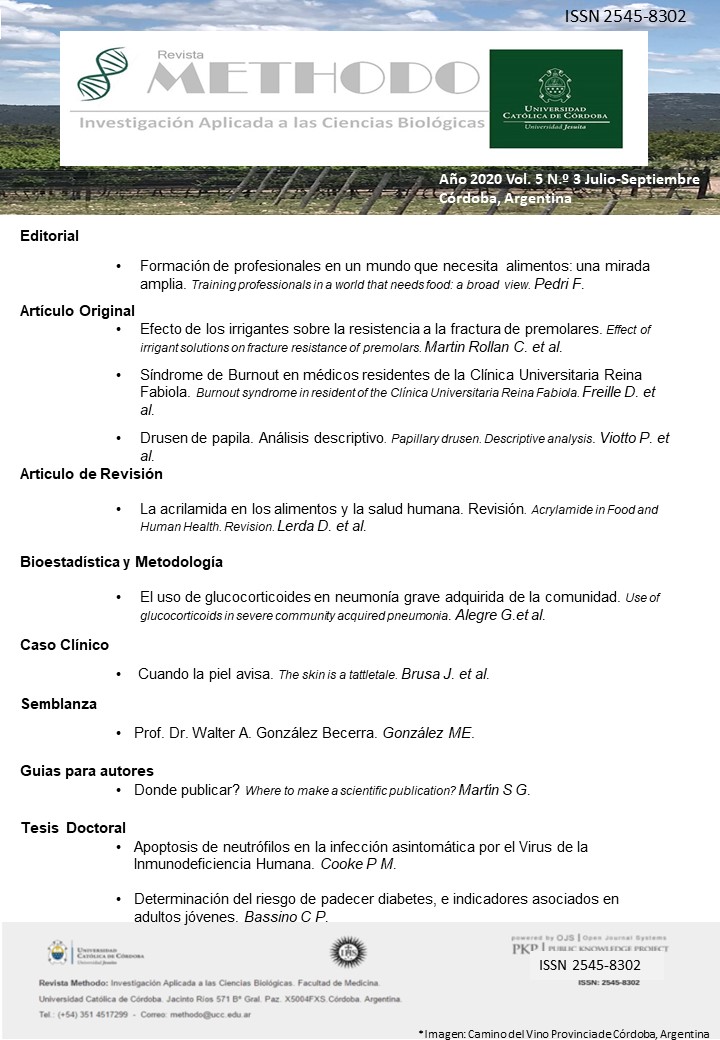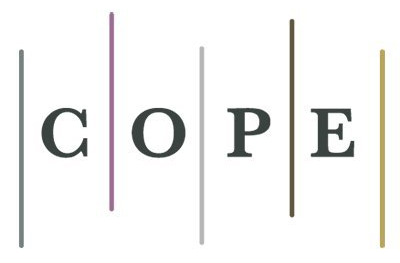Apoptosis de neutrófilos en la infección asintomática por el Virus de la Inmunodeficiencia Humana
DOI:
https://doi.org/10.22529/Palabras clave:
VIH, neutrófilos, apoptosis, infección asintomáticaResumen
En los últimos años se ha determinado que los neutrófilos son células altamente versátiles y sofisticadas, cuyas funciones van mucho más allá de la eliminación de los microorganismos. En la infección por VIH el papel de los neutrófilos no está totalmente caracterizado pero actualmente está claro que la relación entre los neutrófilos y el VIH-1 es mucho más compleja de lo que se pensaba. Los objetivos de esta Tesis fueron evaluar en pacientes con infección asintomática y sin TAR el efecto de la infección por VIH sobre la muerte celular de los neutrófilos, la expresión de moléculas y receptores de superficie y el nivel sérico de marcadores de activación inmune. En pacientes VIH seropositivos sin TAR hubo un aumento de la apoptosis temprana de los neutrófilos en relación a los grupos controles. Esta apoptosis aumentada no depende de la activación de la vía extrínseca o intrínseca. En estos pacientes se detectó una disminución de la expresión de CD62L y de CD16 en neutrófilos que se correlacionó con el estado inmunológico y el nivel de apoptosis de los neutrófilos. Además, se caracterizaron dos subpoblaciones de neutrófilos en base a la expresión de CD11b: una CD11balto y otra CD11bintermedia. Según la coexpresión de moléculas de superficie, se pudieron caracterizar dos subpoblaciones de neutrófilos: una CD11altoCD16alto y una CD11bintermedioCD16-. Por otro lado, hubo un aumento de la expresión de TLR2 que, unido a la expresión de moléculas de adhesión y al aumento de la apoptosis temprana, es indicativo de un fenotipo activado de los neutrófilos. Los niveles aumentados de IL-6 y de PCR-as, pero no los de TNF, se correlacionaron con la carga viral y el estado inmunológico. El nivel de apoptosis de los neutrófilos se correlacionó inversamente con los niveles séricos de IL-6. En conclusión, esta Tesis ha aportado información sobre distintos aspectos relacionados con la apoptosis de los neutrófilos en estadios tempranos de la infección por VIH y por lo tanto contribuye a una mayor comprensión sobre el efecto de este virus sobre componentes de la respuesta inmune innata y sobre el rol de los neutrófilos en la patogénesis de la infección.Descargas
Referencias
Bastian A, Schafer H. Human a-defensin 1 (HNP-1) inhibits adenoviral infection in vitro. Regul Pept. 2001;101:157-61. https://doi.org/10.1016/S0167-0115(01)00282-8
Yasin B, Wang W, Pang M, et al. Theta defensins protect cells from infection by herpes simplex virus by inhibiting viral adhesion and entry. J Virol. 2004; 78:5147-56. https://doi.org/10.1128/JVI.78.10.5147-5156.2004
Scapini P, Lapinet-Vera JA, Gasperini S, et al. The neutrophil as a cellular source of chemokines. Immunol Rev. 2000;177:195-203. https://doi.org/10.1034/j.1600-065X.2000.17706.x
Van Gisbergen KP, Sanchez-Hernandez M, Geijtenbeek TBH, et al. Neutrophils mediate immune modulation of dendritic cells through glycosylation- dependent interactions between Mac-1 and DC-SIGN. J Exp Med. 2005;201:1281-92. https://doi.org/10.1084/jem.20041276
Biswas P, Mantelli B, Sica A, et al. Expression of CD4 on human peripheral blood neutrophils. Blood. 2003; 101:4452-56. https://doi.org/10.1182/blood-2002-10-3056
Salmen S, Guillermo C, Colmenares M, et al. Papel del Virus de la Inmunodeficiencia Humana en la apoptosis de leucocitos de pacientes infectados. Invest Clin. 2005; 46: 289-305.
Pitrak DL. Neutrophil deficiency and dysfunction in HIV-infected patients. Am J Health Syst Pharm. 1999; 56: S9-16. https://doi.org/10.1093/ajhp/56.suppl_5.S9
Murphy PM, Lane HC, Fauci AS, et al. Impairment of neutrophil bactericidal capacity in patients with AIDS. J Infect Dis. 1988 ;158:627-30. https://doi.org/10.1093/infdis/158.3.627
Pitrak DL, Bak PM, DeMarais P, et al. Depressed neutrophil superoxide production in human immunodeficiency virus infection. J Infect Dis. 1993; 167:1406-10. https://doi.org/10.1093/infdis/167.6.1406
Bandres JC, Trial J, Musher DM, et al. Increased phagocytosis and generation of reactive oxygen products by neutrophils and monocytes of men with stage 1 human immunodeficiency virus infection. J Infect Dis. 1993;168:75-83. https://doi.org/10.1093/infdis/168.1.75
Elbim C, Monceaux V, Mueller YM, et al. Early divergence in neutrophil apoptosis between pathogenic and nonpathogenic simian immunodeficiency virus infections of nonhuman primates. J Immunol. 2008; 181:8613-23. https://doi.org/10.4049/jimmunol.181.12.8613
Pitrak DL, Tsai HC, Mullane KM, et al. Accelerated neutrophil apoptosis in the acquired immunodeficiency syndrome. J Clin Invest. 1996;98:2714-19. https://doi.org/10.1172/JCI119096
Baldelli F, Preziosi R, Francisci D, et al. Programmed granulocyte neutrophil death in patients at different stages of HIV infection. AIDS. 2000;14:1067-69. https://doi.org/10.1097/00002030-200005260-00024
Salmen S, Teran G, Borges L, et al. Increased Fas-mediated apoptosis in polymorphonuclear cells from HIV-infected patients. Clin Exp Immunol. 2004;137:166-72. https://doi.org/10.1111/j.1365-2249.2004.02503.x
Mastroianni CM, Mengoni F, Lichtner M, et al. Ex vivo and in vitro effect of human immunodeficiency virus protease inhibitors on neutrophil apoptosis. J Infect Dis. 2000;182:1536-39. https://doi.org/10.1086/315858
Galluzi L, Vitale I, Abrams J, et al. Molecular definitios of cell death subroutines: recommendations of the Nomenclature Committee on Cell Death 2012. Cell Death and Differ. 2012; 19:107-20. https://doi.org/10.1038/cdd.2011.96
Anita HP, Paras J, Patnaik A. Apoptosis (programmed dell death)- A review. World J Pharm Res. 2014;3:1854-72.
Galluzzi L, Aaronson SA, Abrams J, et al. Guidelines for the use and interpretation of assays for monitoring cell death in higher eukaryotes. Cell Death and Differ. 2009;16:1093-107. https://doi.org/10.1038/cdd.2009.44
Mascotti K, Mcculloug J, Burger SR. HPC viability measurement: trypan blue versus acridine orange and propidium iodide. Transfusion. 2000;40:693-96. https://doi.org/10.1046/j.1537-2995.2000.40060693.x
Zhivotosky B. Assessment of Apoptosis and Necrosis by DNA Fragmentation and Morphological Criteria. Curr Protoc Cell Biol. 2001;18.3.1-18.3.23. https://doi.org/10.1002/0471143030.cb1803s12
Collins JA, Schandl CA, Young KK, et al. Major DNA Fragmentation Is a Late Event in Apoptosis. J Histochem Cytochem. 1997;45:923-34. https://doi.org/10.1177/002215549704500702
Elbim C, Katsikis PD, Estaquier J. Neutrophil apoptosis during viral infections. Open Virol Journal. 2009;3:52-9. https://doi.org/10.2174/1874357900903010052
Salmen S, Montes H, Soyano A, et al. Mechanisms of neutrophil death in human immunodeficiency virus-infected patients: Role of reactive oxygen species, caspases and map kinase pathway. Clin Exp Immunol. 2007;150:539-45. https://doi.org/10.1111/j.1365-2249.2007.03524.x
Kuritzkes DR. Neutropenia, Neutrophil Dysfunction and Bacterial Infection in Patients with Human Immunodeficiency Virus Disease: The Role of Granulocyte Colony-Stimulating Factor. Clin Infect Dis. 2000;30:256-60. https://doi.org/10.1086/313642
Lou HR, Loison F. Constitutive neutrophil apoptosis: Mechanisms and regulation. Am J Hematol. 2008;83:288-95. https://doi.org/10.1002/ajh.21078
Lichtner M, Mengoni F, Mastroianni CM, et al. HIV protease inhibitor therapy reverses neutrophil apoptosis in AIDS patients by direct calpain inhibition. 2006. https://doi.org/10.1007/s10495-006-5699-5
Salmen S, Berrueta L, Montes H. Inmunopatogenia de la infección por el virus de la inmunodeficiencia humana. Revista Médica de la Extensión Portuguesa. 2007;1:29-44.
Casulli S, Elbim C. Interactions between human immunodeficiency virus type 1 and polymorphonuclear neutrophils. J Innate Immun. 2014;6:13-20. https://doi.org/10.1159/000353588
Zhang L, Yu W, He T, Yu J, et al. Contribution of human alpha-defensin 1, 2, and 3 to the anti-HIV-1 activity of CD8 antiviral factor. Science. 2002;298:995-1000. https://doi.org/10.1126/science.1076185
Demirkhanyan LH, Marin M, Padilla-Parra S, et al. Multifaceted mechanisms of HIV-1 entry inhibition by human a-defensin. J Biol Chem. 2012;287:28821-38. https://doi.org/10.1074/jbc.M112.375949
Seidel A, Ye Y, de Armas LR, et al. Cyclic and Acyclic Defensins Inhibit Human Immunodeficiency Virus Type-1 Replication by Different Mechanisms. PloSOne. 2010; 5:e9737. https://doi.org/10.1371/journal.pone.0009737
Kuhn L, Trabattoni D, Kankasa C, et al. Alpha-defensins in the prevention of HIV transmission among breastfed infants. J Acquir Immune Defic Syndr. 2005;39:138-42.
Yang D, Chertov O, Bykovskaia SN, et al. Beta-defensins: linking innate and adaptive immunity through dendritic and T cell CCR6. Science.1999;286:52528. https://doi.org/10.1126/science.286.5439.525
Mohan T, Sharma C, Bhat AA, et al. Modulation of HIV peptide antigen specific cellular immune response by synthetic a- and p-defensin peptides. Vaccine. 2013;31:1707-16. https://doi.org/10.1016/j.vaccine.2013.01.041
Robinson WE, McDougall B, Tran D, et al. Anti-HIV-1 activity of indolicidin, an antimicrobial peptide from neutrophils. J Leukoc Biol. 1998;63:94-100. https://doi.org/10.1002/jlb.63.1.94
Saitoh T, Komano J, Saitoh Y, et al. Neutrophil extracellular traps mediate a host defense response to Human Immunodeficiency Virus-1. Cell Host Microbe. 2012;12:109-16. https://doi.org/10.1016/j.chom.2012.05.015
Klebanoff SJ, Coombs RW. Viricidal effect of polymorphonuclear leukocytes on human immunodeficiency virus-1: Role of the myeloperoxidase system. J Clin Invest. 1992;89:2014-17. https://doi.org/10.1172/JCI115810
Ebim C, Prevot MH, Bouscarat F, et al. Polymorphonuclear Neutrophils from Human Immunodeficiency Virus-infected patients show enhanced activation, diminished fMLP-Induced L-Selectin shedding, and an impaired oxidative burst after cytokine priming. Blood. 1994;84:2759-66. https://doi.org/10.1182/blood.V84.8.2759.2759
Vassena L, Giuliani E, Koppensteiner H, et al. HIV-1 and Vpu Interfere with L- Selectin (CD62L) cell surface expression to inhibit adhesion and signaling in infected CD4+ T Lymphocytes. Journal of Virology. 2015;89:5687-700. https://doi.org/10.1128/JVI.00611-15
Gaddi E, Quiroz E, Balbaryski J, et al. Expresión de L-Selectina en linfocitos T y neutrofilos de niños infectados con HIV. Medicina. 2005;65:131-37. 41. Meddows-Taylor S, Kuhn L, Meyers TM, et al. Altered expression of L-Selectin ( CD62L ) on Polymorphonuclear Neutrophils of children vertically infected with Human Immunodeficiency Virus Type 1. 2001;21:286-92. https://doi.org/10.1023/A:1010935409997
Hayes PJ, Miao YM, Gotch FM, et al. Alterations in blood leucocyte adhesion molecule profiles in HIV-1 infection. Clin Exp Immunol. 1999;117:331-34. https://doi.org/10.1046/j.1365-2249.1999.00983.x
Tedder BTF, Steeber DA, Pizcueta P. L Selectin-deficient mice have Impaired leukocyte recruitment into inflammatory sites.J Exp Med. 1995;181:2259-64. https://doi.org/10.1084/jem.181.6.2259
Homburg CHE, de Haas M, von dem Borne AEG, et al. Human neutrophils lose their surface FcgRIII and acquire annexin V binding sites during apoptosis in vitro. Blood. 1995;85:532-40. https://doi.org/10.1182/blood.V85.2.532.532
Dransfield I, Stocks S, Haslett C. Regulation of cell-adhesion molecule expression and function-associated with neutrophil apoptosis. Blood. 1995;85:3264-73. https://doi.org/10.1182/blood.V85.11.3264.bloodjournal85113264
Meddows-Taylor S, Martin DJ. Altered Expression of Fc -gamma RIII (CD16) on Polymorphonuclear Neutrophils from Individuals with Human Immunodeficiency Virus Type 1 Disease and Pulmonary Tuberculosis. Microbiology. 1997;4:78991. https://doi.org/10.1128/cdli.4.6.789-791.1997
Bangani N, Nakiwala J, Martineau AR, et al. HIV-1 infection impairs CD16 and CD35 mediated opsonophagocytosis of Mycobacterium tuberculosis by human neutrophils. J Acquir Defic Syndr. 2016;73:263-67. https://doi.org/10.1097/QAI.0000000000001103
Mazzolini J, Herit F, Me Bouchet J, et al. Inhibition of phagocytosis in HIV-1- infected macrophages relies on Nef-dependent alteration of focal delivery of recycling compartments. Blood. 2010;115:4226-36. https://doi.org/10.1182/blood-2009-12-259473
Nielsen H, Kharazami A, Faber V. Blood Monocyte and Neutrophil Functions in the Acquired Immune Deficiency Syndrome. Scand J Immunol. 2006;24:29196. https://doi.org/10.1111/j.1365-3083.1986.tb02096.x
Palmer S, Hamblin AS. Increased CD11/CD18 expression on the peripheral blood leukocytes of patients with HIV disease: relationship to disease severity. Clin Exp Immunol. 1993;93:344-49. https://doi.org/10.1111/j.1365-2249.1993.tb08183.x
Schwartz R, Lu Y, Villines D, Sroussi HY. Effect of human immunodeficiency virus infection on S100A8/A9 inhibition of peripheral neutrophils oxidative metabolism. Biomed Pharmacother. 2010;64:572-75. https://doi.org/10.1016/j.biopha.2010.03.005
Elghetany MT, Davis BH. Impact of preanalytical variables on granulocytic 52. surface antigen expression: A review. Cytom Part B - Clin Cytom. 2005;65:1-5. https://doi.org/10.1002/cyto.b.20051
Cloke T, Munder M, Bergin P, et al. Phenotypic alteration of neutrophils in the blood of HIV seropositive patients. PLoS One. 2013;8:1-7. https://doi.org/10.1371/journal.pone.0072034
Selik RM, Mokotoff ED, Branson B, et al. Surveillance Case Definition for HIV Infection. MMWR Recomm Rep USA. 2014;63:1-10.
Fujimoto H, Sakata T, Hamaguchi Y, et al. Flow cytometric method for enumeration and classification of reactive immature granulocyte populations. Commun Clin Cytom. 2000;42:371-78. https://doi.org/10.1002/1097-0320(20001215)42:6<371::AID-CYTO1004>3.0.CO;2-G
Vollbrecht T, Stirner R, Tufman A, et al. Chronic progressive HIV-1 infection is associated with elevated levels of myeloid-derived suppressor cells. AIDS. 2012;26:F31-7. https://doi.org/10.1097/QAD.0b013e328354b43f
Rodriguez PC, Ernstoff MS, Hernandez C, et al. Arginase I-producing myeloid- derived suppressor cells in renal cell carcinoma are a subpopulation of activated granulocytes. Cancer Res. 2009;69:1553-60. https://doi.org/10.1158/0008-5472.CAN-08-1921
Schmielau J, Finn OJ. Activated granulocytes and granulocyte-derived hydrogen peroxide are the underlying mechanism of suppression of T-cell function in advanced cancer patients. Cancer Res. 2001;61:4756-60.
Pillay J, Tak T, Kamp VM, et al. Immune suppression by neutrophils and granulocytic myeloid-derived suppressor cells: similarities and differences. Cell Mol Life Sci. 2013;70:3813-27. https://doi.org/10.1007/s00018-013-1286-4
Pillay J, Kamp VM, van Hoffen E, et al. A subset of neutrophils in human systemic inflammation inhibits T cell responses through Mac-1. J Clin Invest. 2012; 122: 327-36 https://doi.org/10.1172/JCI57990
Greifenberg V, Ribechini E, RóGner S, et al. Myeloid-derived suppressor cell activation by combined LPS and IFN-y treatment impairs DC development. Eur J Immunol. 2009;39:2865-76. https://doi.org/10.1002/eji.200939486
Lechner MG, Megiel C, Russell SM, et al. Functional characterization of human CD33+ and CD11b+ myeloid-derived suppressor cell subsets induced from peripheral blood mononuclear cells co-cultured with a diverse set of human tumor cell lines. J Transl Med. 2011 ;9:90. https://doi.org/10.1186/1479-5876-9-90
Bowers NL, Helton ES, Huijbregts RP, et al. Immune suppression by neutrophils in HIV-1 infection: role of PD-L1/PD-1 pathway. PLoS Pathog. 2014;10: e1003993. https://doi.org/10.1371/journal.ppat.1003993
Gabrilovich DI, Nagaraj S. Myeloid-derived-supressor cells as regulators of the immune system. Nat Rev Immunol. 2009;9:162-74. https://doi.org/10.1038/nri2506
Brenchley JM, Douek DC. Microbial Translocation Across the GI Tract. Annu Rev Immunol. 2012;30:149-73. https://doi.org/10.1146/annurev-immunol-020711-075001
Giraldo DM, Hernandez JC, Velilla P, et al. HIV-1-neutrophil interactions trigger neutrophil activation and Toll-like receptor expression. Immunol Res. 2016;64:93-103. https://doi.org/10.1007/s12026-015-8691-8
Takeuchi O, Akira S. Innate immunity to virus infection. Immunol Rev. 2009;227:75-86. https://doi.org/10.1111/j.1600-065X.2008.00737.x
Vercammen E, Staal J, Beyaert R. Sensing of viral infection and activation of innate immunity by toll-like receptor 3. Clin Microbiol Rev. 2008;21:13-25. https://doi.org/10.1128/CMR.00022-07
Vincent IE, Zannetti C, Lucifora J, et al. Hepatitis B virus impairs TLR9 expression and function in plasmacytoid dendritic cells. PLoS One. 2011 ;6:1 12. https://doi.org/10.1371/journal.pone.0026315
Hernandez JC, Giraldo DM, Paul S, et al. Involvement of Neutrophil Hyporesponse and the Role of Toll-Like Receptors in Human Immunodeficiency Virus 1 Protection. PloS One.2015;10:e0119844. https://doi.org/10.1371/journal.pone.0119844
Martínez Moreno JA, López JCH, Urcuqui-Inchima S. La estimulación de TLR, receptores tipo NOD y dectina-1 en neutrófilos humanos induce la producción de citocinas proinflamatorias. Iatreia. 2014;27:135-46. https://doi.org/10.17533/udea.iatreia.15093
Sabroe I, Prince LR, Jones EC, et al. Selective Roles for Toll-Like Receptor (TLR)2 and TLR4 in the Regulation of Neutrophil Activation and Life Span. J Immunol. 2003;170:5268-75. https://doi.org/10.4049/jimmunol.170.10.5268
Sabroe I, Dower SK, Whyte MKB. The role of Toll-like receptors in the regulation of neutrophil migration, activation and apoptosis. Clin Infect Dis. 2005;41:S4216. https://doi.org/10.1086/431992
Koffel RE, Meshcheryakova A, Warszawska J, et al. Monocytic cell differentiation from band-stage neutrophils under immflamatory conditions via MKK6 activation. Blood. 2014;124:2713-24. https://doi.org/10.1182/blood-2014-07-588178
Lester RT, Yao XD, Ball TB, et al. Toll-like receptor expression and responsiveness are increased in viraemic HIV-1 infection. AIDS. 2008;22:68594. https://doi.org/10.1097/QAD.0b013e3282f4de35
Lee RM, White MR, Hartshorn KL. Influenza A viruses upregulate neutrophil Toll-like receptor 2 expression and function. Scand J Immunol. 2006;63:81-9. https://doi.org/10.1111/j.1365-3083.2005.01714.x
Roberts L, Passmore JS, Williamson C, al. Plasma cytokine levels during acute HIV-1 infection predict HIV disease progression. AIDS 2010;24:819-31. https://doi.org/10.1097/QAD.0b013e3283367836
Kedzierska K, Crowe SM. Cytokines and HIV-1: Interactions and clinical 78. implications. Antivir Chem Chemother. 2001;12:133-50. https://doi.org/10.1177/095632020101200301
Pillay J, Kamp VM, van Hoffen E, et al. A subset of neutrophils in human systemic inflammation inhibits T cell responses through Mac-1. J Clin Invest. 2012;122:327-36. https://doi.org/10.1172/JCI57990
Iwaki D, Mitsuzawa H, Murakami S, et al. The extracellular Toll-like Receptor 2 domain directly binds peptidoglycan derived from Staphylococcus aureus. J Biol Chem. 2002;277:24315-320. https://doi.org/10.1074/jbc.M107057200
Lien E, Sellati TJ, Yoshimura A, et al. Toll-like Receptor 2 Functions as a Pattern Recognition Receptor. J Biol Chem. 1999;274:33419-425. https://doi.org/10.1074/jbc.274.47.33419
Geerin B, Simon H. Peculiarities of cell death mechanisms in neutrophils. Cell Death Differ. 2011;18:1457-69. https://doi.org/10.1038/cdd.2011.75
Reed J. Mechanisms of apoptosis. Am J Pathol. 2000;157:1415-30. https://doi.org/10.1016/S0002-9440(10)64779-7
Voss M, Lettau M, Paulsen M, et al. Posttranslational regulation of Fas ligand function. Cell Commun Signal. 2008;6:11. https://doi.org/10.1186/1478-811X-6-11
Silvestris F, Nagata S, Cafforio P, et al. Cross-linking of Fas by antibodies to a peculiar domain of gp120 V3 loop can enhance T cell apoptosis in HIV-1- infected patients. J Exp Med. 1996;184:2287-300. https://doi.org/10.1084/jem.184.6.2287
Yan J, Zapata JC, Pauza CD, et al. Modulation of SIV and HIV DNA vaccine immunity by Fas-FasL signaling. Viruses. 2015;7:1429-53. https://doi.org/10.3390/v7031429
Clerici M, Shearer GM. A TH1--TH2 switch is a critical step in the etiology of HIV infection. Immunol Today. 1993;14:107-11. https://doi.org/10.1016/0167-5699(93)90208-3
Catalfamo M, Le Saout C, Lane HC. The role of cytokines in the pathogenesis and treatment of HIV infection. Cytokine & Growth Factor Rev. 2012;23:207-14. https://doi.org/10.1016/j.cytogfr.2012.05.007
Baker J V, Quick H, Russ T. IL-6 and D-dimer levels are associated with vascular dysfunction in patients with untreated HIV infection. HIV Med. 2010;11:608-09. https://doi.org/10.1111/j.1468-1293.2010.00835.x
Ledwaba L, Tavel JA, Khabo P, et al. Pre-ART levels of inflammation and coagulation markers are strong predictors of death in a south african cohort with advanced HIV disease. PLoS One. 2012;7(3):e24243. https://doi.org/10.1371/journal.pone.0024243
Boulware DR, Hullsiek KH, Puronen CE, et al. Higher levels of CRP, D-dimer, IL-6 and hyaluronic acid before initiation of antiretroviral therapy (ART) are associated with increased risk of AIDS or death. J Infect Dis. 2011;203:163746. https://doi.org/10.1093/infdis/jir134
Dolan SE, Hadigan C, Killilea KM, et al. Increased cardiovascular disease risk indices in HIV-infected women. J Acquir Immune Defic Syndr. 2005;39:44-54. https://doi.org/10.1097/01.qai.0000159323.59250.83
Vermeire S, Van Assche G, Rutgeerts P. C-Reactive Protein as a marker for inflammatory bowel disease. Inflamm Bowel Dis. 2004;10:661-65. https://doi.org/10.1097/00054725-200409000-00026
Calabro P, Chang DW, Willerson JT, et al. Release of C-Reactive Protein in Response to Inflammatory Cytokines by Human Adipocytes: Linking Obesity to Vascular Inflammation. J Am Coll Cardiol. 2005;46:1112-13. https://doi.org/10.1016/j.jacc.2005.06.017
Calabró P, Willerson JT, Yeh ETH. Inflammatory Cytokines Stimulated C- Reactive Protein Production by Human Coronary Artery Smooth Muscle Cells. Circulation. 2003;108:1930-32. https://doi.org/10.1161/01.CIR.0000096055.62724.C5
Kuller LH, Tracy R, Belloso W, et al. Inflammatory and coagulation biomarkers and mortality in patients with HIV infection. PLoS Med. 2008;5:1496-508. https://doi.org/10.1371/journal.pmed.0050203
Chaudhary M, Kashyap B, Gautam H, et al. Role of C-Reactive Protein in HIV infection: a pilot study. Viral Immunol. 2008;21:263-66. https://doi.org/10.1089/vim.2007.0083
Lau B, Sharrett AR, Kingsley LA, et al. C-Reactive Protein is a marker for human immunodeficiency virus disease progression. Arch Intern Med. 2006;166:64-70. https://doi.org/10.1001/archinte.166.1.64
Eastburn A, Scherzer R, Zolopa AR, et al. Association of low level viremia with inflammation and mortality in HIV-infected adults. PLoS One. 2011;6(11):e26320. https://doi.org/10.1371/journal.pone.0026320
Catalfamo M, Di Mascio M, Hu Z, et al. HIV infection-associated immune activation occurs by two distinct pathways that differentially affect CD4 and CD8 T cells. Proc Natl Acad Sci U S A. 2008; 105:19851 -56. https://doi.org/10.1073/pnas.0810032105
Catalfamo M, Wilhelm C, Tcheung L, et al. CD4 and CD8 T cell immune activation during chronic HIV infection: roles of homeostasis, HIV, type I IFN, and IL-7. J Immunol. 2011;186:2106-16. https://doi.org/10.4049/jimmunol.1002000
Enocsson H, Sjowall C, Skogh T, et al. Interferon-a mediates suppression of C- reactive protein explanation for muted C-reactive protein response in lupus flares? Arthritis Rheum. 2009;60(12):3755-60. https://doi.org/10.1002/art.25042
Borato DCK, Parabocz GC, Ribas SRW, et al. Changes of metabolic and inflammatory markers in HIV infection: Glucose, lipids, serum Hs-CRP and myeloperoxidase. Metabolism. 2012;61:1353-60. https://doi.org/10.1016/j.metabol.2012.03.003
Masiá M, Bernal E, Padilla S, et al. The role of C-Reactive Protein as a marker for cardiovascular risk associated with antiretroviral therapy in HIV-infected patients. Atherosclerosis. 2007;195:167-71. https://doi.org/10.1016/j.atherosclerosis.2006.09.013
Guimaraes MMM, Greco DB, Figueiredo SM, et al. High-sensitivity C-reactive Protein levels in HIV-infected patients treated or not with antiretroviral drugs and their correlation with factors related to cardiovascular risk and HIV infection. Atherosclerosis. 2008;201:434-39. https://doi.org/10.1016/j.atherosclerosis.2008.02.003
Neuhaus J, Baker J V, Calmy A, et al. Markers of inflammation, coagulation and renal function are elevated in Adults with HIV Infection. J Infect Dis. 2011;201:1788-95. https://doi.org/10.1086/652749
Zangerle R, Gallati H, Sarcletti M, et al. Tumor necrosis factor alpha and soluble tumor necrosis factor receptors in individuals with human immunodeficiency virus infection. Immunol Lett. 1994;41:229-34. https://doi.org/10.1016/0165-2478(94)90138-4
Fahey JL, Taylor JM, Manna B, et al. Prognostic significance of plasma markers of immune activation, HIV viral load and CD4 T-cell measurements. AIDS. 1998;12:1581-90. https://doi.org/10.1097/00002030-199813000-00004
Wong GH, Krowka JF, Stites DP, et al. In vitro anti-human immunodeficiency virus activities of tumor necrosis factor-alpha and interferon-gamma. J Immunol. 1988;140:120-24. https://doi.org/10.4049/jimmunol.140.1.120
Folks TM, Clouse KA, Justement J, et al. Tumor necrosis factor alpha induces expression of human immunodeficiency virus in a chronically infected T-cell clone. Proc Natl Acad Sci. 1989;86:2365-68. https://doi.org/10.1073/pnas.86.7.2365
Keating SM, Golub ET, Nowicki M, et al. The effect of HIV infection and HAART on inflammatory biomarkers in a population-based cohort of US women. AIDS. 2011; 25:1823-32. https://doi.org/10.1097/QAD.0b013e3283489d1f
Pontes-Cardoso LCR, Souza LR, Peragoli MTS, et al. Cytokine Profile and clinical metabolic alterations in HIV-1 infected individuals with and without lipodistrphy. J Venom Anim Toxins incl Trop Dis. 2007;13:509-26. https://doi.org/10.1590/S1678-91992007000200009
Ledru E, Christeff N, Patey O, et al. Alteration of tumor necrosis factor-alpha T- cell homeostasis following potent antiretroviral therapy: contribution to the development of human immunodeficiency virus-associated lipodystrophy syndrome. Blood. 2000;95:3191-98. https://doi.org/10.1182/blood.V95.10.3191
Ledru E, Lecoeur H, Garcia S, et al. Differential susceptibility to activation- induced apoptosis among peripheral Th1 subsets: correlation with Bcl-2 expression and consequences for AIDS pathogenesis. J Immunol. 1998;160:3194-206. https://doi.org/10.4049/jimmunol.160.7.3194
Chen H, Wang C, Chou C, et al. Tumor Necrosis Factor-a induces caspase- independent cell death in human neutrophils via reactive oxidants and associated with calpain activity. J Biomed Sci. 2006;13:621-73. https://doi.org/10.1007/s11373-005-9052-8












